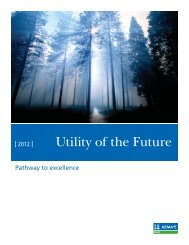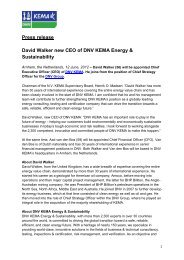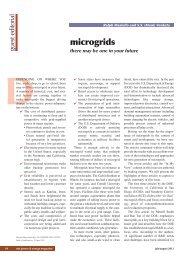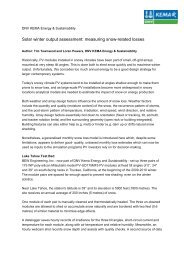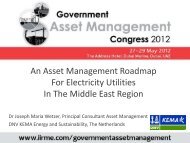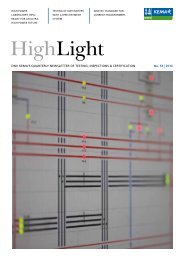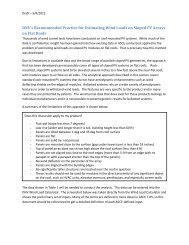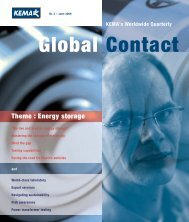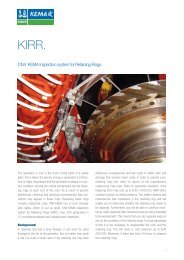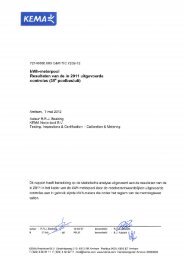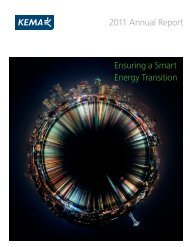Renewable eneRgy SolutionS: emeRging ... - DNV Kema
Renewable eneRgy SolutionS: emeRging ... - DNV Kema
Renewable eneRgy SolutionS: emeRging ... - DNV Kema
You also want an ePaper? Increase the reach of your titles
YUMPU automatically turns print PDFs into web optimized ePapers that Google loves.
cycle costs of a 20 megawatts flywheel-basedpower plant designed to perform frequencyregulation ancillary services in three independentsystem operator (ISO) markets.KEMA developed a model to compare thelife cycle cost of a flywheel plant with fourtypes of commercially available fossil powergeneration technologies used to perform frequencyregulation services, as well as with alead acid battery storage system functioningsimilarly to the flywheel system. Results of theanalysis show that flywheel-based regulationcan be expected to have significantly lower lifecycle costs (LCC) compared to several competingtechnologies studied. The modelingalso examined CO 2, SOx, and NOx emissionsand demonstrated that flywheel-based frequencyregulation can be expected to createsignificantly lower NOx and SO 2emissions.Several European energy storage projects inwhich KEMA is involved may also have usefulapplications in the North American market. Oneof these, the Redox Flow battery, presents aninteresting alternative to traditional pumped orcompressed air energy storage. The Redox Flowtechnology combines an electrode and catalystassembly with a membrane electrode assemblyinto one operational system. It is anticipatedthat this type of storage technology can assist inthe integration of small-scale, sustainable generationunits into the distribution network whilemaintaining power quality.Another European storage project involvedtransportable storage systems. Transportablestorage provides a flexible asset for networkmanagement, introducing possibilities for deferralof investment in expensive switchgear andavoidance of stranded assets. KEMA is part ofa European consortium for the Sixth FrameworkProgram, a demonstration project usingtransportable and flexible storage systems withparticipation from France, the Netherlands,Poland, Italy, Cyprus, Germany and Spain. Storagesystems will be evaluated at five sites usinga technical/economic assessment tool, whichincludes intelligent prediction software. Eachstorage system will be tested at a minimum oftwo sites, to assure that the storage systemscan be successfully transported and operated.Tapping into the Power of Blue EnergyA promising renewable energy technology,Blue Energy, is derived from harnessing thephysical and chemical differences betweenfresh and salt water. Like osmosis, the processuses membranes. However, instead of usingpressure to create energy, Blue Energy relieson reverse electrodialysis.KEMA is currently testing this technology inthe Netherlands and believes that Blue Energyhas the potential to generate ten times more power thancurrently generated in the Netherlands from wind farms.This capability would have significant environmentalbenefits, since no greenhouse gases are released ingenerating the electricity. This technology has enormouspotential for other countries rich with river deltas,such as Brazil, China and Bangladesh.What is Blue Energy?Blue Energy is the name given to electricity producedby harnessing the difference between fresh water andsalt water. It requires two types of membranes, one thatis selectively permeable for positive ions and one that isselectively permeable for negative ions. Salt water thatis separated from fresh water between two such mem-48 EnergyBiz March/April 2008Thought Leadership – sponsored by KEMA
Technical illustration by Rudolf and Robert Das.The Energy Island in the Netherlands and Europe works by incorporatingpumped hydro storage in an inverse offshore pump accumulationstation (IOPAC).branes will lose both its positive ions and negative ions.This charge separation produces a potential differencethat can be used directly as electrical energy.The technology’s key material is special membranesmade from the electrical modification ofplastics. Thanks to recent advances by KEMA in theelectrical modification of plastics, the special membranesneeded for Blue Energy now can be madeeconomically. The new application of KEMA’s electricalmodification method to the production of ionexchanging membranes means that Blue Energy isbecoming more affordable. While prices do need tofall further and the membrane quality needs furtherimprovement before the technology becomes trulyeconomically feasible, advances in this technologyprovide exciting insight into the possibilitiesof our energy future.How does Blue Energy work?Fresh water naturally tries to mix with saltwater. Fresh and salt water can be placedin adjacent tanks separated by the specialmembranes. Once the fresh water has passedthrough the membranes, it will not flow backthe other way, leaving potential energy thatcan be tapped with a water turbine.Blue Energy plants could be created atevery river mouth. Best applications of thistechnology are in coastal areas such as theThought LeadershiP – sponsored by KEMA www.energycentral.com EnergyBiz 49
Netherlands, India, or Bangladesh. Plants canbe situated at sites where fresh water floatsinto the sea or at industries with salt wastewater streams. It is anticipated that plantsof 25 megawatts and greater could provideenergy at a cost that is roughly equal to thecost of offshore wind. Larger plants may beable to achieve even lower costs, especiallyif a concentrated salt solution such as brine isavailable.KEMA is currently developing a plant composedof multiple modules with a total capacityof 250 kilowatts, to be initially located at acoastal test site.Energy Island HarnessesOffshore Wind EnergyAnother new concept, the Energy Island, isgenerating much interest in the Netherlandsand Europe. Designed by KEMA, Lievense andthe Das brothers, the concept incorporatespumped hydro storage in an inverse offshorepump accumulation station (IOPAC).How does this work?When there is a surplus of wind energy onthe Energy Island, the excess energy is usedto pump sea water out of the interior ‘subsurface-lake’into the surrounding sea. Whenthere is a shortage of wind power, sea wateris allowed to flow back into the interior ‘lake’through commercially available generators toproduce energy. The IOPAC is unique comparedto conventional pumped hydro storagesystems in that it would be stationed onan artificial island off the Dutch coast in theNorth Sea and composed of a ring of dikessurrounding a 50-meter deep reservoir. Theisland itself would be built from materialsdredged to deepen the interior reservoir.KEMA analysis estimates that the proposedEnergy Island storage system would have amaximum generation capacity of 1,500 megawatts,depending on the water level. The systemalso would have an annual storage capacity ofmore than 20 gigawatt hours – enough energyto offset 500 to 840 kilotons of CO 2emissions.KEMA will soon conduct further analysis ofthe costs and benefits of additional regulatingreserve, download wind power, CO 2reduction,and environmental impacts.The combination of electricity storage andoffshore wind energy provides synergies.Electricity storage is a well-established practicethat offers considerable added value forthe energy sector. Storage increases the technicalreliability of the power supply, stabilizesthe cost of electricity, and can help to holddown CO 2emissions. Investment in largescalestorage can substitute for investment in thereplacement or new development of peak productioncapacity. The integration of electricity storage withinthe power supply has numerous environmental benefits,particularly if storage is combined with windpoweredgenerating capacity on a large scale.The first phase of an ongoing feasibility studyrecently concluded that the Energy Island is an attractiveand technically feasible renewable energy option.In the next phase, KEMA will participate in a detailedlocation study to investigate technical capabilities,and economic and ecological viability.What tomorrow’s technologiesmean for today’s utilitiesThere are many commercially viable energy storageand renewable energy options available to utilitiestoday. In addition, there are numerous exciting renewableenergy solutions currently under developmentthat may be commercially operational within the nextdecade. Today’s utilities are looking to develop comprehensivestrategies to incorporate clean technologies,renewable energy and the efficient delivery anduse of electricity.KEMA brings together a strong understanding ofthe best available clean technologies as well as themost promising emerging technologies to help utilitiesplan their future energy portfolios. This expertiseis combined with extensive experience in electricpower grid operations, renewable energy projectdevelopment and grid integration, a deep understandingof the current state of energy infrastructure,comprehensive experience with integrated resourceplanning, and expertise in evolving regulatory policies.KEMA offers services and solutions that addressthe complex issues of developing renewable energyin a rapidly changing environment.For more information about KEMA’s renewable energyservices, visit our website at www.kema.com or callus at (781.273.5700).50 EnergyBiz March/April 2008Thought Leadership – sponsored by KEMA




